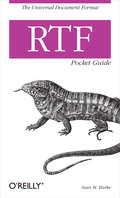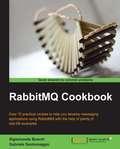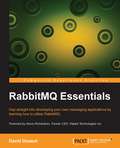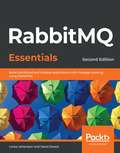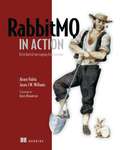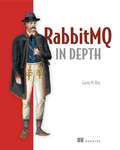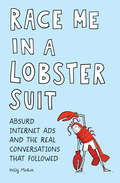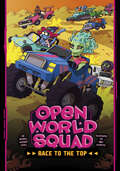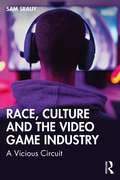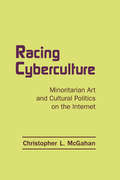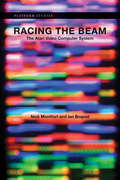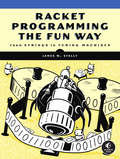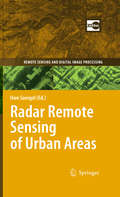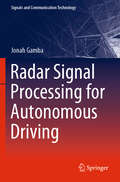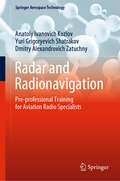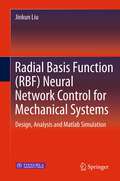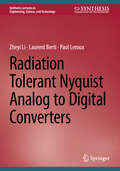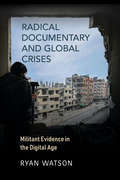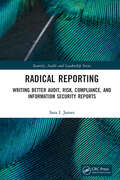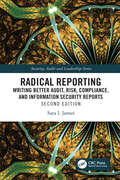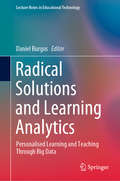- Table View
- List View
RTF Pocket Guide
by Sean M. Burke<p>Any programmer working with text files today needs a way to deal with Microsoft® Word documents and their underlying Rich Text Format. RTF is notoriously difficult to work with, and our handy quick reference is the only book available on what many developers call "this maddeningly unstructured format." Small and easy to use on the job, <i>RTF Pocket Guide</i> focuses on the "workhorse" codes that programmers can't do without, including text style codes, paragraph formatting codes, and page formatting codes-- all with many examples of real use.</p>
RTF Pocket Guide: The Universal Document Format
by Sean M. BurkeRich Text Format, or RTF, is the internal markup language used by Microsoft Word and understood by dozens of other word processors. RTF is a universal file format that pervades practically every desktop. Because RTF is text, it's much easier to generate and process than binary .doc files. Any programmer working with word processing documents needs to learn enough RTF to get around, whether it's to format text for Word (or almost any other word processor), to make global changes to an existing document, or to convert Word files to (or from) another format.RTF Pocket Guide is a concise and easy-to-use tutorial and quick-reference for anyone who occasionally ends up mired in RTF files. As the first published book to cover the RTF format in any detail, this small pocket guide explains the syntax of RTF with examples throughout, including special sections on Unicode RTF and MSHelp RTF, and several full programs that demonstrate how to work in RTF effectively.Most word processors produce RTF documents consisting of arcane and redundant markup. This book is the first step to finding order in the disorder of RTF.
RTFM: Red Team Field Manual v2
by Ben Clark Nick DownerOver 8 years ago, the Red Team Field Manual (RTFM) was born out of operator field notes inspired by years of Red Team missions. While tools and techniques change, operators still constantly find themselves in common operating environments, with time running out. The RTFM has provided a quick reference when there is no time to scour the Internet for that perfect command. RTFM version 2 has been completely overhauled, with the addition of over 290 new commands and techniques. It has also been thoroughly updated and tested to ensure it works against modern operating systems. Version 2 includes a new Mac OS section and a section outlining tradecraft considerations. Searching has been streamlined through an expanded table of contents and appendix, and readability has been considerably improved through new text formatting. Finally, RTFM v2 will come in multiple formats including paperback, hardback (coming August 2022), Kindle eBook and an all-new wide margin note taking edition.
RabbitMQ Cookbook
by Gabriele Santomaggio Sigismondo BoschiA practical book filled with advanced recipes as well as plenty of code and real-life examples which will make your learning curve quick and easy.If you are a software developer who wants to develop distributed applications based on messaging, then this book is for you. It's assumed that you have some experience with multithreading applications and distributed applications. You are also expected to know the basic concepts of Web and cloud applications in order to follow the recipes effectively.
RabbitMQ Essentials
by David DossotThis book is a quick and concise introduction to RabbitMQ. Follow the unique case study of Clever Coney Media as they progressively discover how to fully utilize RabbitMQ, containing clever examples and detailed explanations. Whether you are someone who develops enterprise messaging products professionally or a hobbyist who is already familiar with open source Message Queuing software and you are looking for a new challenge, then this is the book for you. Although you should be familiar with Java, Ruby, and Python to get the most out of the examples, RabbitMQ Essentials will give you the push you need to get started that no other RabbitMQ tutorial can provide you with.
RabbitMQ Essentials - Second Edition: Build distributed and scalable applications with message queuing using RabbitMQ, 2nd Edition
by David Dossot Lovisa JohanssonWhether you are someone who develops enterprise messaging products professionally or a hobbyist familiar with open source message queuing software and looking for a new challenge, RabbitMQ Essentials is for you. This book will give you the push you need to get started with creating new and exciting applications or migrating existing monoliths to a microservice architecture.
RabbitMQ in Action: Distributed Messaging for Everyone
by Jason WilliamsSummaryRabbitMQ in Action is a fast-paced run through building and managing scalable applications using the RabbitMQ messaging server. It starts by explaining how message queuing works, its history, and how RabbitMQ fits in. Then it shows you real-world examples you can apply to your own scalability and interoperability challenges.About the TechnologyThere's a virtual switchboard at the core of most large applications where messages race between servers, programs, and services. RabbitMQ is an efficient and easy-to-deploy queue that handles this message traffic effortlessly in all situations, from web startups to massive enterprise systems.About the BookRabbitMQ in Action teaches you to build and manage scalable applications in multiple languages using the RabbitMQ messaging server. It's a snap to get started. You'll learn how message queuing works and how RabbitMQ fits in. Then, you'll explore practical scalability and interoperability issues through many examples. By the end, you'll know how to make Rabbit run like a well-oiled machine in a 24 x 7 x 365 environment.Written for developers familiar with Python, PHP, Java, .NET, or any other modern programming language. No RabbitMQ experience required. Purchase of the print book comes with an offer of a free PDF, ePub, and Kindle eBook from Manning. Also available is all code from the book. What's InsideLearn fundamental messaging design patternsUse patterns for on-demand scalabilityGlue a PHP frontend to a backend written in anythingImplement a PubSub-alerting service in 30 minutes flatConfigure RabbitMQ's built-in clusteringMonitor, manage, extend, and tune RabbitMQ============================================Table of ContentsPulling RabbitMQ out of the hatUnderstanding messagingRunning and administering RabbitSolving problems with Rabbit: coding and patternsClustering and dealing with failureWriting code that survives failureWarrens and Shovels: failover and replicationAdministering RabbitMQ from the WebControlling Rabbit with the REST APIMonitoring: Houston, we have a problemSupercharging and securing your Rabbit Smart Rabbits: extending RabbitMQ
RabbitMQ in Depth
by Gavin M. RoySummaryRabbitMQ in Depth is a practical guide to building and maintaining message-based applications. This book provides detailed coverage of RabbitMQ with an emphasis on why it works the way it does.Purchase of the print book includes a free eBook in PDF, Kindle, and ePub formats from Manning Publications.About the TechnologyAt the heart of most modern distributed applications is a queue that buffers, prioritizes, and routes message traffic. RabbitMQ is a high-performance message broker based on the Advanced Message Queueing Protocol. It?s battle tested, ultrafast, and powerful enough to handle anything you can throw at it. It requires a few simple setup steps, and you can instantly start using it to manage low-level service communication, application integration, and distributed system message routing.About the BookRabbitMQ in Depth is a practical guide to building and maintaining message-based applications. This book provides detailed coverage of RabbitMQ with an emphasis on why it works the way it does. You'll find examples and detailed explanations based in real-world systems ranging from simple networked services to complex distributed designs. You'll also find the insights you need to make core architectural choices and develop procedures for effective operational management. What's InsideAMQP, the Advanced Message Queueing ProtocolCommunicating via MQTT, Stomp, and HTTPValuable troubleshooting techniquesDatabase integrationAbout the ReaderWritten for programmers with a basic understanding of messaging-oriented systems.About the AuthorGavin M. Roy is an active, open source evangelist and advocate who has been working with internet and enterprise technologies since the mid-90s. Technical editor James Titcumb is a freelance developer, trainer, speaker, and active contributor to open source projects.Table of ContentsPART 1 - RABBITMQ AND APPLICATION ARCHITECTUREFoundational RabbitMQ How to speak Rabbit: the AMQ Protocol An in-depth tour of message properties Performance trade-offs in publishing Don't get messages; consume them Message patterns via exchange routing PART 2 - MANAGING RABBITMQ IN THE DATA CENTER OR THE CLOUDScaling RabbitMQ with clusters Cross-cluster message distribution PART 3 - INTEGRATIONS AND CUSTOMIZATIONUsing alternative protocols Database integrations
Race Me in a Lobster Suit: Absurd Internet Ads and the Real Conversations that Followed
by Kelly MahonThis collection of prank Craigslist ads and the real email exchanges that followed is the perfect gift for fans of offbeat humor. When New York City copywriter Kelly Mahon started posting fake gig ads online as a creative outlet, she was surprised to find that there was someone interested in every bizarre job offer she dreamed up. Race Me in a Lobster Suit collects Mahon’s funniest posts, along with the improvised email exchanges with would-be cocoon knitters and lobster racers. Some correspondents became suspicious, while others seemed willing to play along. The result is good-natured comedy gold and a kind of collaborative entertainment that could only exist in the internet gig economy. Irreverent illustrations by cartoonist Graham Annable (creator of the Harvey Award nominated Grickle comics) ensure that this small book offers outsize laughs. A quick, hilarious read, Race Me in a Lobster Suit is perfect for anyone who needs a bit of absurdity to brighten their day.
Race to the Top (Open World Squad)
by Michael Anthony SteeleThe gamer squad is entering a racing challenge! In this Open World level, vehicles are equipped with battle gadgets, and the group must work together to outwit NPC drivers. Thirteen-year-old Hanna, however, seems more focused on performing flashy stunts. That’s because lately, she’s been missing the spotlight. IRL, Hanna is used to being a theater star, but after moving in with her grandparents, she’s at a bigger school with bigger talent. Now she’s not sure she’ll even be cast in the upcoming play and is feeling lost. With help from her squad, can Hanna settle in and learn it’s okay to play a supporting role? Game on with Open World Squad, an illustrated hi-lo chapter book series featuring exciting video game action and a winning mix of easy-to-read narrative text and in-game chat conversations.
Race, Culture and the Video Game Industry: A Vicious Circuit
by Sam SrauyA detailed and much needed examination of how systemic racism in the US shaped the culture, market logic, and production practices of video game developers from the 1970s until the 2010s. Offering historical analysis of the video game industries (console, PC, and indie) from a critical, political economic lens, this book specifically examines the history of how such practices created, enabled, and maintained racism through the imagined ‘gamer.’ The book explores how the cultural and economic landscape of the United States developed from the 1970s through the 2000s and explains how racist attitudes are reflected and maintained in the practices of video games production. These practices constitute a 'Vicious Circuit' that normalizes racism and the centrality of an imagined gamer identity. It also explores how the industry, from indie game developers to larger profit-driven companies, responded to changing attitudes in the 2010s, where racism and lack of diversity in games was frequently being noted. The book concludes by offering potential solutions to combat this ‘Vicious Circuit’.A vital contribution to the study of video games that will be welcomed by students and scholars in the fields of media studies, cultural studies, game studies, critical race studies, and beyond.
Racing Cyberculture: Minoritarian Art and Cultural Politics on the Internet (Routledge Studies in New Media and Cyberculture #3)
by Christopher L. McGahanRacing Cyberculture explores new media art that challenges the 'race-blind' myth of cyberspace. The particular cultural workers whose productions are addressed are the performance and installation artist Guillermo Gomez-Pena and Roberto Sifuentes, the UK new media arts collective Mongrel, the conceptual artists and composer Keith Obadike, and the multimedia artist Prema Murthy. The author looks at how works by these artists bring forward questions of racial and cultural identity as they intersect with information technology.
Racing Rivals Guida Non Ufficiale del Gioco
by Stefania Pezzato Joshua AbbottCon la mia Guida del Gioco imparerai esattamente ciò che ti serve saper per diventare un giocatore esperto e ottenere soldi infiniti! Questa è una guida completa con tutti quello che devi sapere sul gioco e IN PIÙ potrai anche scaricare la tua copia gratuita del gioco con questo acquisto. - Panoramica & Informazioni di Base. - Suggerimenti e Strategie Professionali. - Come Guadagnare Soldi Infiniti. - Come Battere i vostri Avversari. - Trucchi e Hack. - Istruzioni Dettagliati Semplici da Seguire. - Segreti, Suggerimenti, Cheat, Sbloccabili, e Trucchi Usati dai Pro Player! - E MOLTO ALTRO! Compralo ora e sconfiggi i tuoi avversari! Diventa un Pro Player oggi! Disclaimer: Questo prodotto non è associato, affiliato, promosso o sponsorizzato da Hu Wen Zeng. Questa guida deve essere utilizzata come un riferimento. Non modifica o altera il gioco in alcun modo. Questa è una guida scritta e non un programma software.
Racing the Beam: The Atari Video Computer System (Platform Studies)
by Nick Montfort Ian BogostA study of the relationship between platform and creative expression in the Atari VCS.The Atari Video Computer System dominated the home video game market so completely that “Atari” became the generic term for a video game console. The Atari VCS was affordable and offered the flexibility of changeable cartridges. Nearly a thousand of these were created, the most significant of which established new techniques, mechanics, and even entire genres. This book offers a detailed and accessible study of this influential video game console from both computational and cultural perspectives. Studies of digital media have rarely investigated platforms—the systems underlying computing. This book (the first in a series of Platform Studies) does so, developing a critical approach that examines the relationship between platforms and creative expression. Nick Montfort and Ian Bogost discuss the Atari VCS itself and examine in detail six game cartridges: Combat, Adventure, Pac-Man, Yars' Revenge, Pitfall!, and Star Wars: The Empire Strikes Back. They describe the technical constraints and affordances of the system and track developments in programming, gameplay, interface, and aesthetics. Adventure, for example, was the first game to represent a virtual space larger than the screen (anticipating the boundless virtual spaces of such later games as World of Warcraft and Grand Theft Auto), by allowing the player to walk off one side into another space; and Star Wars: The Empire Strikes Back was an early instance of interaction between media properties and video games. Montfort and Bogost show that the Atari VCS—often considered merely a retro fetish object—is an essential part of the history of video games.
Racket Programming the Fun Way: From Strings to Turing Machines
by James. W. StellyAn introduction to the Racket functional programming language and DrRacket development environment to explore topics in mathematics (mostly recreational) and computer science.At last, a lively guided tour through all the features, functions, and applications of the Racket programming language. You'll learn a variety of coding paradigms, including iterative, object oriented, and logic programming; create interactive graphics, draw diagrams, and solve puzzles as you explore Racket through fun computer science topics--from statistical analysis to search algorithms, the Turing machine, and more.Early chapters cover basic Racket concepts like data types, syntax, variables, strings, and formatted output. You'll learn how to perform math in Racket's rich numerical environment, and use programming constructs in different problem domains (like coding solutions to the Tower of Hanoi puzzle). Later, you'll play with plotting, grapple with graphics, and visualize data. Then, you'll escape the confines of the command line to produce animations, interactive games, and a card trick program that'll dazzle your friends.You'll learn how to: • Use DrRacket, an interactive development environment (IDE) for writing programs • Compute classical math problems, like the Fibonacci sequence • Generate two-dimensional function plots and create drawings using graphics primitives • Import and export data to and from Racket using ports, then visually analyze it • Build simple computing devices (pushdown automaton, Turing machine, and so on) that perform tasks • Leverage Racket's built-in libraries to develop a command line algebraic calculatorRacket Programming the Fun Way is just like the language itself--an embodiment of everything that makes programming interesting and worthwhile, and that makes you a better programmer.
Radar Remote Sensing of Urban Areas
by Uwe SoergelThis book presents a unique collection of state-of-the-art contributions by international remote sensing experts focussing on methodologies to extract information about urban areas from Synthetic Aperture Radar (SAR) data. SAR is an active remote sensing technique capable to gather data independently from sun light and weather conditions. Emphasizing technical and geometrical issues the potential and limits of SAR are addressed in focussed case studies, for example, the detection of buildings and roads, traffic monitoring, surface deformation monitoring, and urban change. These studies can be sorted into two groups: the mapping of the current urban state and the monitoring of change. The former covers, for instance, methodologies for the detection and reconstruction of individual buildings and road networks; the latter, for example, surface deformation monitoring and urban change. This includes also investigations related to the benefit of SAR Interferometry, which is useful to determine either digital elevation models and surface deformation or the radial velocity of objects (e.g. cars), and the Polarization of the signal that comprises valuable information about the type of soil and object geometry. Furthermore, the features of modern satellite and airborne sensor devices which provide high-spatial resolution of the urban scene are discussed.
Radar Signal Processing for Autonomous Driving (Signals and Communication Technology)
by Jonah GambaThe subject of this book is theory, principles and methods used in radar algorithm development with a special focus on automotive radar signal processing. In the automotive industry, autonomous driving is currently a hot topic that leads to numerous applications for both safety and driving comfort. It is estimated that full autonomous driving will be realized in the next twenty to thirty years and one of the enabling technologies is radar sensing. This book presents both detection and tracking topics specifically for automotive radar processing. It provides illustrations, figures and tables for the reader to quickly grasp the concepts and start working on practical solutions. The complete and comprehensive coverage of the topic provides both professionals and newcomers with all the essential methods and tools required to successfully implement and evaluate automotive radar processing algorithms.
Radar and Radionavigation: Pre-professional Training for Aviation Radio Specialists (Springer Aerospace Technology)
by Dmitry Alexandrovich Zatuchny Anatoly Ivanovich Kozlov Yuri Grigoryevich ShatrakovThis book highlights the capabilities and limitations of radar and air navigation. It discusses issues related to the physical principles of an electromagnetic field, the structure of radar information, and ways to transmit it. Attention is paid to the classification of radio waves used for transmitting radar information, as well as to the physical description of their propagation media. The third part of the book addresses issues related to the current state of navigation systems used in civil aviation and the prospects for their development in the future, as well as the history of satellite radio navigation systems. The book may be useful for schoolchildren, interested in the problems of radar and air navigation.
Radial Basis Function (RBF) Neural Network Control for Mechanical Systems
by Jinkun LiuRadial Basis Function (RBF) Neural Network Control for Mechanical Systems is motivated by the need for systematic design approaches to stable adaptive control system design using neural network approximation-based techniques. The main objectives of the book are to introduce the concrete design methods and MATLAB simulation of stable adaptive RBF neural control strategies. In this book, a broad range of implementable neural network control design methods for mechanical systems are presented, such as robot manipulators, inverted pendulums, single link flexible joint robots, motors, etc. Advanced neural network controller design methods and their stability analysis are explored. The book provides readers with the fundamentals of neural network control system design. This book is intended for the researchers in the fields of neural adaptive control, mechanical systems, Matlab simulation, engineering design, robotics and automation. Jinkun Liu is a professor at Beijing University of Aeronautics and Astronautics.
Radiation Tolerant Nyquist Analog to Digital Converters (Synthesis Lectures on Engineering, Science, and Technology)
by Paul Leroux Zheyi Li Laurent BertiThis book presents the detailed design considerations and techniques for radiation-tolerant (RT) Nyquist analog-to-digital converters (ADC). It begins with the fundamental radiation effects in space and its consequences in modern CMOS technology. Next, radiation effects on ADCs from the transistor level to the architectural level are examined and a detailed design tradeoffs and strategies for radiation-tolerant ADCs are described. The theory and hardening techniques are supported by measurement data from a high-performance RT-ADC prototype chip. Two important flows, which are a technology evaluation flow and an RT IC design flow, are also covered, in order to give a complete overview on how to achieve an effective RT circuits design.
Radical Documentary and Global Crises: Militant Evidence in the Digital Age
by Ryan WatsonWhen independent filmmakers, activists, and amateurs document the struggle for rights, representation, and revolution, they instrumentalize images by advocating for a particular outcome. Ryan Watson calls this "militant evidence."In Radical Documentary and Global Crises, Watson centers the discussion on extreme conflict, such as the Iraq War, the occupation of Palestine, the war in Syria, mass incarceration in the United States, and child soldier conscription in the Congo. Under these conditions, artists and activists aspire to document, archive, witness, and testify. The result is a set of practices that turn documentary media toward a commitment to feature and privilege the media made by the people living through the terror. This footage is then combined with new digitally archived images, stories, and testimonials to impact specific social and political situations. Radical Documentary and Global Crises re-orients definitions of what a documentary is, how it functions, how it circulates, and how its effect is measured, arguing that militant evidence has the power to expose, to amass, and to adjudicate.
Radical Reporting: Writing Better Audit, Risk, Compliance, and Information Security Reports (Security, Audit and Leadership Series)
by Sara I. JamesMost people dread writing reports; they also dread reading reports. What they don’t realize is that the techniques that make writing more readable make it more powerful. This is especially relevant for professionals in areas such as audit, risk, compliance, and information security. This small volume provides the tools and techniques needed to improve reports. It does so through addressing crucial concepts all too often overlooked in the familiar rush to perform tasks, complete projects, and meet deadlines. These concepts – the role of culture in communication; the link between logic and language; the importance of organizing thoughts before writing; and how to achieve clarity – may seem academic or theoretical. They’re not. Unless writers understand their own thoughts, actions, and objectives, they cannot hope to communicate them at all – let alone clearly.
Radical Reporting: Writing Better Audit, Risk, Compliance, and Information Security Reports (Security, Audit and Leadership Series)
by Sara I. James"If I were giving out an award for 'book of the year' for internal audit professionals, I would certainly award it to her outstanding manuscript: Radical Reporting: Writing Better Audit, Risk, Compliance and Information Security Reports." - Richard Chambers, Former President and CEO, The Institute of Internal AuditorsMost people dread writing reports; they also dread reading reports. What they don’t realize is that the techniques that make writing more readable make it more powerful. This is especially relevant for professionals in areas such as audit, risk, compliance, and information security.This small volume provides the tools and techniques needed to improve reports. It does so through addressing crucial concepts all too often overlooked in the familiar rush to perform tasks, complete projects, and meet deadlines.These concepts – the role of culture in communication; the link between logic and language; the importance of organizing thoughts before writing; and how to achieve clarity – may seem academic or theoretical. They’re not. Unless writers understand their own thoughts, actions, and objectives, they cannot hope to communicate them at all – let alone clearly.This second edition develops these points with additional material on critical thinking, as well as the use of AI in reporting.
Radical Secrecy: The Ends of Transparency in Datafied America (Electronic Mediations #60)
by Clare BirchallReimagining transparency and secrecy in the era of digital data When total data surveillance delimits agency and revelations of political wrongdoing fail to have consequences, is transparency the social panacea liberal democracies purport it to be? This book sets forth the provocative argument that progressive social goals would be better served by a radical form of secrecy, at least while state and corporate forces hold an asymmetrical advantage over the less powerful in data control. Clare Birchall asks: How might transparency actually serve agendas that are far from transparent? Can we imagine a secrecy that could act in the service of, rather than against, a progressive politics? To move beyond atomizing calls for privacy and to interrupt the perennial tension between state security and the public&’s right to know, Birchall adapts Édouard Glissant&’s thinking to propose a digital &“right to opacity.&” As a crucial element of radical secrecy, she argues, this would eventually give rise to a &“postsecret&” society, offering an understanding and experience of the political that is free from the false choice between secrecy and transparency. She grounds her arresting story in case studies including the varied presidential styles of George W. Bush, Barack Obama, and Donald Trump; the Snowden revelations; conspiracy theories espoused or endorsed by Trump; WikiLeaks and guerrilla transparency; and the opening of the state through data portals.Postsecrecy is the necessary condition for imagining, finally, an alternative vision of &“the good,&” of equality, as neither shaped by neoliberal incarnations of transparency nor undermined by secret state surveillance. Not least, postsecrecy reimagines collective resistance in the era of digital data.
Radical Solutions and Learning Analytics: Personalised Learning and Teaching Through Big Data (Lecture Notes in Educational Technology)
by Daniel BurgosLearning Analytics become the key for Personalised Learning and Teaching thanks to the storage, categorisation and smart retrieval of Big Data. Thousands of user data can be tracked online via Learning Management Systems, instant messaging channels, social networks and other ways of communication. Always with the explicit authorisation from the end user, being a student, a teacher, a manager or a persona in a different role, an instructional designer can design a way to produce a practical dashboard that helps him improve that very user’s performance, interaction, motivation or just grading. This book provides a thorough approach on how education, as such, from teaching to learning through management, is improved by a smart analysis of available data, making visible and useful behaviours, predictions and patterns that are hinder to the regular eye without the process of massive data.
